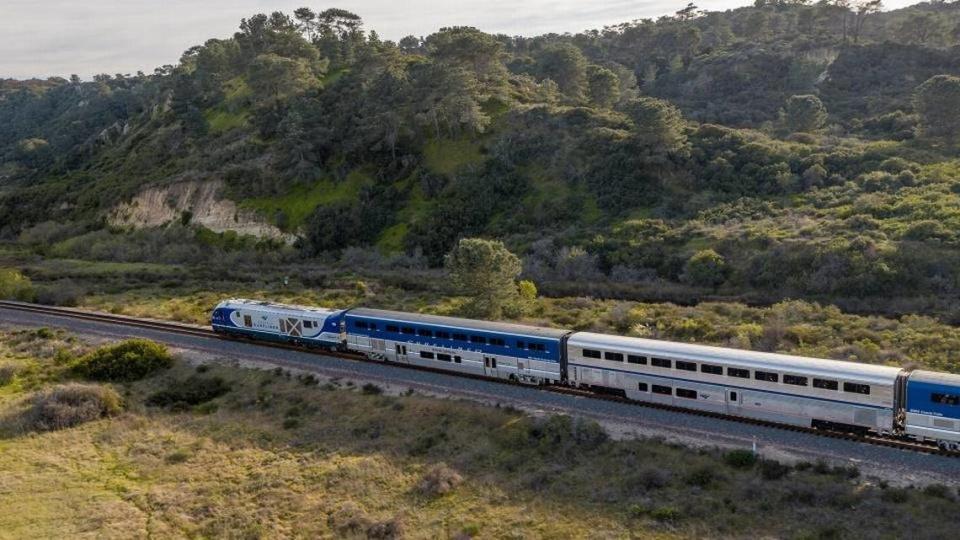Trains could run between SLO and San Jose every few hours one day. Here’s how
Californians could have more options to travel up and down the state by rail in the coming years, including multiple new routes between the Central Coast and Silicon Valley that could one day see trains running every few hours.
Next year, the Federal Railroad Administration’s Corridor Identification and Development Program will give Caltrans $1 million to develop a plan to expand rail service, according to a news release from Central Coast Congressman Salud Carbajal, D-Santa Barbara.
This could include adding a new train that travels between San Luis Obispo and San Jose, along with improving the Pacific Surfliner in Southern California, according to Caltrans assistant deputy director of rail transportation Kyle Gradinger.
“Expanding passenger rail options for traveling the Central Coast will not only give our communities better ways to travel our region, but it will continue to bring new visitors to our local economies without additional traffic and with a lower carbon footprint,” Carbajal said in the news release. “That’s a win-win for us all.”
Here’s a look at how train service could change for San Luis Obispo County travelers during the next decade and beyond.
Expanding train service from SLO to San Jose
The biggest goal of the effort calls for improving regional train service between San Luis Obispo and San Jose, so that people can quickly and easily travel shorter distances without relying on Amtrak’s long-haul Coast Starlight line.
To begin the process, Caltrans will use $500,000 of the grant to develop a plan to expand train service in that corridor, according to Gradinger.
Right now, Amtrak’s Coast Starlight train runs once a day from Seattle to Los Angeles in both directions, and passengers must use this route to travel between San Luis Obispo and San Jose.
But the Coast Starlight is often inconvenient for passengers, according to Gradinger.
“It can often be delayed along that incredibly long route,” Gradinger said. “Some of the trains travel at pretty difficult times that don’t work with people’s schedules — late night, early morning.”
Caltrans’ goal is to create a faster, more convenient train service for passengers traveling in the area, Gradinger said.
“The point is to give people more options to travel at times that are more convenient and more helpful for their trips,” he said.
The $500,000 will fund the creation of a service development plan, which will outline route options, potential ridership, revenue, environmental impacts and service options, including how many trips a day the train will make between the two cities, according to Gradinger.
Once Caltrans completes the plan, it will apply for federal funding to make the project a reality.
Gradinger said he expects that the first additional train on this route to be available by 2030.
By 2050, Caltrans aims to have multiple trains running between San Luis Obispo and San Jose every few hours, he said.

Improving Amtrak’s Pacific Surfliner
Caltrans will use the other $500,000 to develop a plan to improve the Pacific Surfliner, which travels between San Luis Obispo and San Diego.
The service is the second busiest passenger rail corridor in the United States with 12 trains per day, Gradinger said.
“We’re starting from a completely different point here, but what we want to look at is continual improvement of the corridor,” he said.
Caltrans’ goal is to have a train running every hour between Los Angeles and San Diego, along with expanding service options between San Luis Obispo and Santa Barbara, according to Grandinger.
The agency is also considering adding an extension to San Ysidro, a city in San Diego County near the Mexico border.
Additionally, Caltrans is exploring ways to make the Pacific Surfliner more resilient to extreme weather patterns, he said.
“We’re going to pay special attention to climate change mitigation and adaptation,” Gradinger said.
Finally, Caltrans is working to design an even more energy efficient train service.
“Trains are already the cleanest mode of transportation,” Gradinger said. “But we’re working to improve the performance of our state-owned rail equipment so we can meet the state’s really ambitious zero emission goals.”

